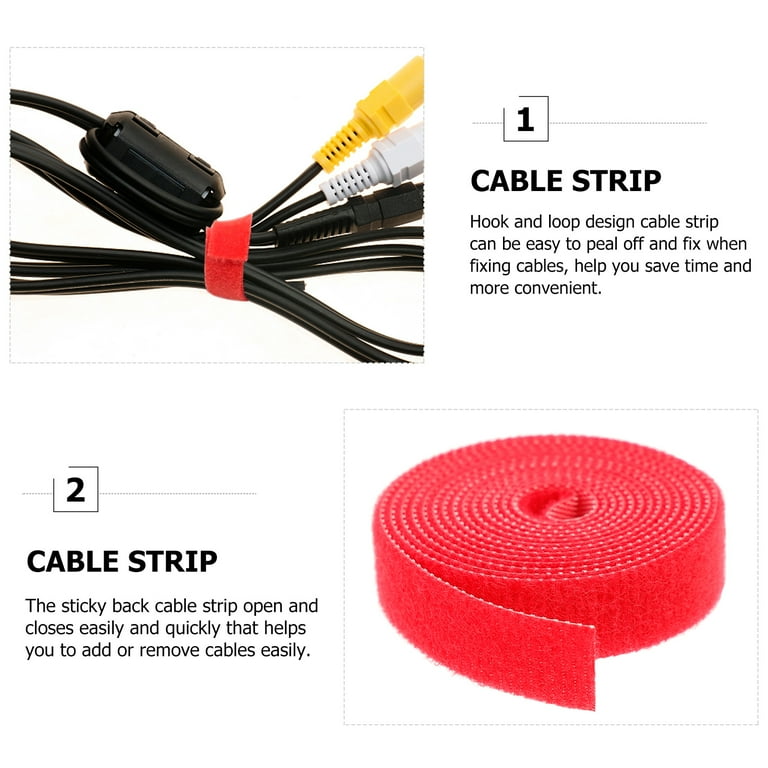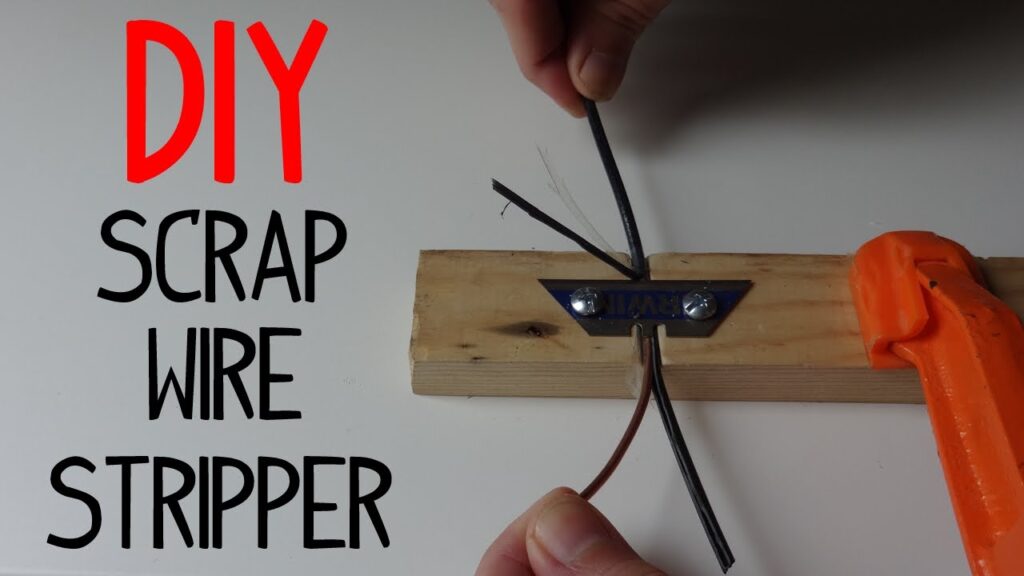To strip wire, first select the appropriate tool, then adjust it to the wire gauge. Grip the wire with the tool and pull to remove the insulation.
Stripping wire is a fundamental skill necessary for various electrical projects, from installing a new light fixture to splicing wires for custom electronics. It involves removing the protective insulation from the end of a wire to expose the metal conductor for electrical contacts.
The key to efficient wire stripping is using the right tool, such as wire strippers, a utility knife, or an automatic stripping machine, each suited for different wire sizes and types. Proper technique ensures a clean strip without damaging the wire’s conductor, which is crucial for maintaining electrical conductivity and safety. Remember to always cut away from your body and wear protective eyewear to safeguard against any stray strands or debris during the process.

Credit: www.eternaltools.com
The Need For Efficient Wire Stripping
Efficient wire stripping is critical for both safety and performance in electrical work. Properly stripped wires ensure a secure and conductive connection, which is essential for any electrical system. With the advancement of technology, the variety and complexity of wires have increased. This demands precision in the wire stripping process to avoid damage to the wires’ integrity and functionality.
The Role Of Wire Stripping In Electrical Work
Wire stripping involves removing the protective coating of a wire to expose the metal conductor inside. This step is fundamental for creating electrical connections. Stripping wires allows for the metal core to be connected to other wires or terminals, forming an electrical circuit. Effective wire stripping ensures a low-resistance contact and prevents potential hazards like short circuits and electrical fires.
Challenges In Manual Wire Stripping
- Inconsistent Strip Lengths: It’s hard to maintain uniformity in strip length.
- Damaged Conductors: Manual stripping often results in nicked or severed strands.
- Time-Consuming: Stripping wires by hand is slow and can delay projects.
- Risk of Injury: Using manual tools can lead to cuts or repetitive strain injuries.
Mastering manual wire stripping can be daunting for even experienced electricians. A single mistake can lead to project setbacks or worse, electrical faults. This underscores the importance of pursuing efficient wire stripping techniques and tools.
Essential Tools For Wire Stripping
Stripping wire can be simple with the right tools. We need certain essentials to get the job done effectively. These tools remove wire insulation cleanly and safely. Let’s explore the must-have tools for this task.
Wire Strippers: Types And Uses
Wire strippers are the main heroes in stripping wires. Different projects need different types of wire strippers.
- Manual Wire Strippers: These require hand strength but give you control. They work well for basic jobs.
- Automatic Wire Strippers: These adjust to wire size automatically. Perfect for quick, consistent strips.
- Adjustable Wire Strippers: You set the size. Ideal for precision work on various wire sizes.
- Gauged Wire Strippers: These have specific holes for wire sizes. Great for repeated tasks with the same wire size.
Additional Tools To Aid The Process
Besides wire strippers, other tools make the process smoother.
| Tool | Function |
|---|---|
| Diagonal Cutters | Cut wires to length before stripping. |
| Wire Cutter | Snip away unwanted wire parts. |
| Nose Pliers | Bend, reposition, or hold the wire. |
| Utility Knife | Carefully slit insulation when needed. |
Use a sharp knife with care. Always strip away from your body to avoid injury.
Preparation: Setting Up Your Workspace
Before working with wires, a well-organized workspace is crucial. Good preparation ensures safety and efficiency. Think of it like setting the stage for a performance. Each tool and material needs its spot. Let’s make sure the setup is perfect to handle the task at hand.
Safety First: Protective Gear
Ensuring your safety is a priority. Protective gear is a must.
- Gloves protect your hands from sharp edges.
- Safety glasses shield your eyes from any possible debris.
- Long sleeves help protect your skin from minor scrapes.
Keep a first-aid kit nearby for added precaution. Always wear your gear before starting.
Organizing Your Work Area For Optimal Efficiency
Start with a clean, flat surface. Clear away clutter to avoid distractions and potential hazards.
| Area | Tools | Materials |
|---|---|---|
| Main Workspace | Wire strippers, pliers, cutters | Wires you’re working with |
| Storage Zone | Extra tools, tape | Additional connectors |
| Disposal Bin | Safe discard for stripped materials | |
Label your tools and materials if you’re a beginner. This makes finding things easier.
Arrange tools within arm’s reach. Keep a small bin for waste. This keeps your area neat and saves time.
Understanding Wire Gauge Sizes
Before stripping wires, knowing the wire gauge is key. Wire gauge refers to the wire’s thickness. Thicker wires carry more current. The gauge number tells the wire size. The higher the number, the thinner the wire. Understanding this is crucial for choosing the right tools and technique for stripping.
Matching Tools To Wire Size
Wire stripping requires the right tools. The most common tools are:
- Wire strippers: These come with notches for different gauges.
- Adjustable strippers: They adjust to wires of various sizes.
- Automatic strippers: They self-adjust to the wire gauge.
Here’s a quick selection guide:
| Wire Gauge | Tool Type |
|---|---|
| 10-18 | Standard wire strippers |
| 20-22 | Precision wire strippers |
| 24+ | Automatic wire strippers |
Adjusting Tools For Different Gauges
To strip a wire properly:
- Determine the wire’s gauge.
- Choose the matching notch or adjust the tool accordingly.
- Place the wire in the stripper and squeeze gently.
- Pull the insulation to reveal the bare wire.
Tip: Always test the tool on a small wire piece to prevent damaging the wire.
Remember to recalibrate automatic strippers or adjust the tension screw on adjustable tools when switching between wire sizes. This ensures clean and safe stripping every time.
Technique Matters: Step-by-step Stripping Guide
Preparing wires for a project is crucial, and how you strip them matters greatly. An improper technique might damage the wire or create unsafe conditions. This step-by-step stripping guide ensures you master the technique, giving you clean, perfect wire ends every time. Let’s roll up our sleeves and get to the nitty-gritty of stripping wires like a pro.
Cutting The Wire To Length
Measurement is key before you cut. Here’s how to do it:
- Use a wire gauge tool to identify your wire’s size.
- Mark the desired length using a wire marker or tape.
- Choose wire cutters that match your wire’s gauge.
- Hold the wire near the cut point and squeeze the cutters swiftly to make a clean cut.
This method ensures precision and prepares the wire for the stripping process.
The Right Way To Grip And Strip
Stripping the wire properly is essential. Follow these steps:
- Select the correct stripping tool for your wire gauge.
- Open the tool’s jaws and place the wire between them at the strip point.
- Grip the wire with one hand and the stripper with the other.
- Squeeze the handles and pull toward the end to remove the insulation.
A firm, steady grip and the right tool will give you a clean strip every time.
Additional Tips For Successful Wire Stripping
| Tip | Reason |
|---|---|
| Avoid twisting the wire | Keeps the wire strands intact |
| Do not nick the wire | Prevents future wire breakage |
| Check the stripped end | Ensures a perfect strip for connection |
With these techniques, your wires will be prepared perfectly for any task.
Troubleshooting Common Wire Stripping Problems
When taking on any wiring project, it’s crucial to ensure a clean strip. Mishaps can lead to faulty connections and safety hazards. So let’s tackle common wire stripping issues and make sure your work remains both safe and efficient.
Dealing With Damaged Insulation
Wire insulation must remain intact to protect the copper inside. When stripping wire, you might face damaged insulation, making it tougher to remove. Here’s a quick fix:
- Use the correct tool. The wrong tool can grip too hard or not enough.
- Adjust the tool. Many strippers have a dial for different wire gauges.
- Practice technique. Aim for a clean, swift motion to remove insulation.
Avoiding Wire Nicks And Cuts
Nicks and cuts can weaken wires, leading to breaks or short circuits. To prevent this:
| Step | Tip |
|---|---|
| 1. | Check your tool’s blades. They must be sharp and precise. |
| 2. | Align the wire properly. Place it in the correct notch for its size. |
| 3. | Gently squeeze and rotate. Do not pull the stripper hard. |
By following these steps, you can strip wires with confidence.
“` This HTML content provides a structured and engaging section for a blog post, with specific troubleshooting steps to handle common wire stripping issues, while being presented in a user-friendly manner that’s suitable for publishing on a WordPress site.
Maintaining Your Wire Stripping Tools
Keeping your wire stripping tools in top condition is essential. Well-maintained tools ensure safety and efficiency. Follow these guidelines for optimal performance.
Cleaning Best PracticesCleaning Best Practices
Regular cleaning prevents buildup and prolongs tool life.
- Disconnect tools from power sources.
- Use a soft cloth or brush to remove debris.
- Wipe with mild solvent to clear grease.
- Dry completely before next use.
Sharpening And Aligning Blades
Sharp blades make stripping wires easier. Use a honing stone for best results:
- Disassemble the tool if necessary.
- Glide the blade along the stone.
- Check the edge for consistency.
- Reassemble and test on scrap wire.
Blade alignment is crucial for clean cuts:
- Inspect blades for proper positioning.
- Adjust as needed according to the manual.
- Ensure tight fittings for optimal performance.
Advanced Tips For Stripping Wires
Mastering the art of wire stripping saves time and improves efficiency. Experienced electricians often seek ways to optimize this fundamental task. Advanced tips can transform a mundane chore into a sleek, streamlined process.
Automating The Process
Stripping wires by hand works well but can be tiresome for large projects. Automating the process ensures consistent results and increases productivity. Consider these steps:
- Invest in an automatic wire stripper if repetitive tasks are common.
- Choose the right tool for the gauges of wire you frequently use.
- Adjust machine settings to match the insulation type and wire size.
- Perform regular maintenance to keep the equipment in top condition.
Experiment with machine settings for optimal speed and precision. Your workspace efficiency will noticeably improve.
Heat-shrinking For Insulation
Once a wire is stripped, insulating it properly is crucial for safe operation. Heat-shrinking tubing provides a seamless insulation solution. Follow these expert tips:
- Select the correct size of heat shrink tubing for the wire.
- Cut the tubing to a suitable length to cover the exposed area.
- Place the tubing over the wire before you connect it, if possible.
- Use a heat gun to evenly apply heat until the tubing conforms tightly to the wire.
Properly applied, heat-shrink tubing provides long-lasting protection against the elements and wear.
Recycling Stripped Wire Insulation
Stripping wire can leave you with a pile of insulation. Finding ways to recycle this insulation is crucial. Here’s how to manage those leftovers responsibly.
Environmental Considerations
Recycling wire insulation benefits the planet. It reduces landfill waste. It also saves energy. This is crucial for a healthy environment. Wire insulation consists of materials like PVC or polyethylene. These can take centuries to degrade. Recycling them is the best way to help Earth.
- Preserve natural resources: Recycling conserves raw materials.
- Lower carbon footprint: It minimizes the carbon emissions from the production of new materials.
- Reduce landfill waste: Keeps non-biodegradable plastics out of landfills.
Methods For Repurposing Or Disposing Of Insulation
There are creative ways to repurpose wire insulation. You can also dispose of it in an eco-friendly way. Here are some methods:
| Method | Description |
|---|---|
| Local recycling center | Take insulation to a center that accepts plastics. |
| DIY crafts | Use the insulation for creative projects like jewelry or art. |
| Industrial recycling | Contact companies that recycle industrial materials. |
Remember to check with your local recycling rules. Not all centers accept all plastic types, and preparation might be needed before recycling.

Credit: www.walmart.com
Putting Your Skills To Practice
Found your groove with the wire strippers? Great! The real fun begins after mastering the basics. Putting skills to use gives confidence and leads to amazing DIY creations. Let’s jump into some cool projects and ways to level up those wire stripping abilities!
Diy Projects To Try Out
Home projects come alive with a bit of wirework. Try these:
- Handmade Jewelry: Use thin wire scraps to craft unique pieces.
- Custom Lighting: Build a lamp or chandelier with stripped wires.
- Electronics Repair: Fix cables or gadgets by splicing wires.
Gaining Additional Experience Through Mini-courses
Want more hands-on learning? Mini-courses boost your skills. They offer:
- Structured Guidance: Follow step-by-step instructions.
- Project Ideas: Get inspired for new creations.
- Advanced Techniques: Learn to work with different wires.
Check local community centers or online platforms for these mini-courses. Start small, dream big, and watch your wire stripping craft soar!

Credit: www.amazon.com
Frequently Asked Questions On How To Strip Wire
Is Stripping Wire Necessary Before Recycling?
Stripping wire before recycling is essential for maximizing profit. It removes the insulation, allowing recyclers to access the valuable copper or metal inside. By stripping wire, you ensure a higher purity grade for the metal, which increases its recycling value.
What Tools Are Best For Wire Stripping?
For manual wire stripping, wire strippers or wire cutters are the ideal tools. For larger volumes or thicker wires, using a specialized wire stripping machine can greatly increase efficiency and precision, ultimately saving time.
Can You Strip Wire Without A Tool?
Stripping wire without a tool is possible but not recommended. Using a knife or scissors can be dangerous and result in uneven or damaged wire. For safety and consistency, using the appropriate wire-stripping tool is advised.
How Do You Avoid Damaging Wire While Stripping?
To prevent damage while stripping wire, use the correct size slot on a wire stripper and gently apply pressure. Avoid twisting or pulling the wire too vigorously. Always consult the tool’s guide for the appropriate gauge settings.
Conclusion
Stripping wire doesn’t have to be daunting. With the right tools and techniques, it’s a simple task. Always prioritize safety and precision for best results. Found this guide helpful? Share it with fellow DIY enthusiasts. Keep practicing, and soon you’ll master the art of wire stripping.


